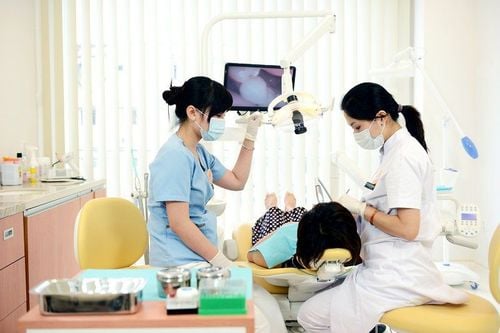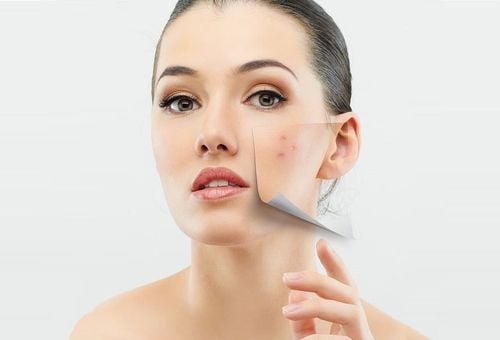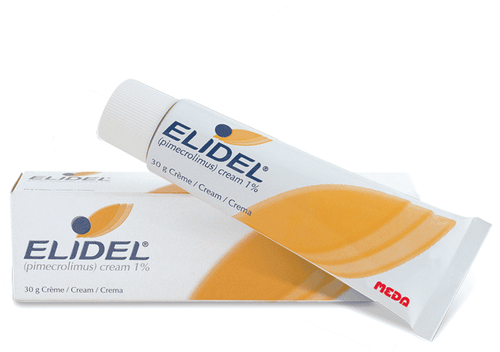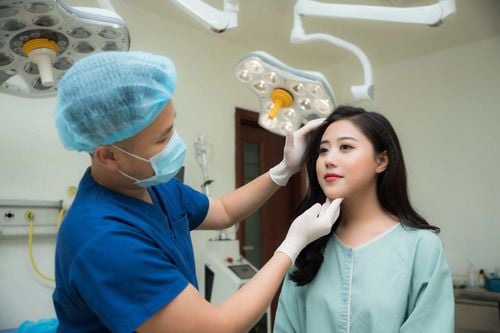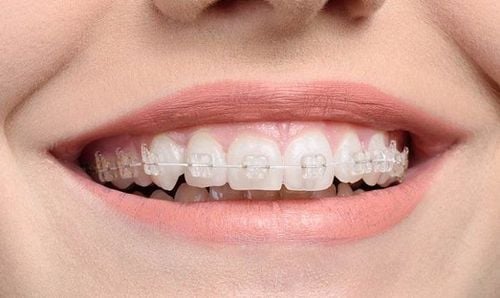This is an automatically translated article.
Melasma is a common skin condition that affects both men and women. However, it is more common in women and dark-skinned people. Melasma is less common in men, but it negatively affects quality of life in men as much as it does in women. Although melasma has been studied in detail in women, however, there are only a handful of studies on the clinical pathology and treatment of melasma in men.
Melasma is a common skin condition characterized by the appearance of symmetrical, irregular, light to dark brown hyperpigmentation associated with sun-exposed areas, especially on the face. . Although melasma can affect all races and both sexes, it is more common in women of childbearing age and dark-skinned people who live in areas with ultraviolet radiation. UV) high intensity. Hyperpigmentation on exposed areas such as the face can be a cause for cosmetic concern for patients, which can negatively impact quality of life. Melasma in women has been studied in detail, but despite some similarities, there are certain clinical differences, etiology and treatment of melasma in men that still need to be studied. . Understanding the characteristics of male-specific melasma will enable better management of the disorder in male patients. This article aims to highlight the important clinical, etiological, and therapeutic aspects of melasma in men.
The most common areas where melasma appears on the face include:
Bridge of the nose Forehead Cheeks Upper lip Melasma can also appear on other areas of the body, especially those exposed to the sun. sun exposure, including:
Forearms Neck Shoulders According to the American Academy of Dermatology, only 10% of all cases of melasma occur in men. Women with darker skin tones and who are pregnant are more at risk for melasma.
1. Causes of melasma in men
A hormonal imbalance between estrogen and testosterone can be the cause of melasma in men. Estrogen is known to lower blood testosterone and suppress the secretion of luteinizing hormone (LH) and follicle-stimulating hormone (FSH), which in turn further increases estrogen levels by reversing the suppression caused by LH and caused by FSH.
Besides endogenous hormonal factors, the use of exogenous hormone drugs has also been shown to cause melasma. Many cases of melasma following hormone therapy, such as estrogen therapy, have been reported. Finasteride is thought to increase testosterone, which is available for fragrance, to estradiol, which leads to the subsequent formation of melasma.
The use of cosmetics and the consumption of certain drugs and other photosensitizing substances are also associated with the formation of melasma. An Indian study observed that men with melasma (43.9 percent) were more likely to use mustard oil for body and hair massage than women (31.4 percent), although the difference was statistically insignificant. Mustard oil is photosensitive, which can cause hyperpigmentation of the facial skin, mainly in the forehead and temple areas of the face. However, more research is needed to confirm the correlation between mustard oil and melasma.
Some male patients with melasma also have some chronic diseases. However, the association needs to be proven by further studies. Furthermore, an association of melasma with thyroid diseases has also been suggested, with a higher incidence of autoimmune thyroid disease occurring in patients with melasma, but the results are contradictory.
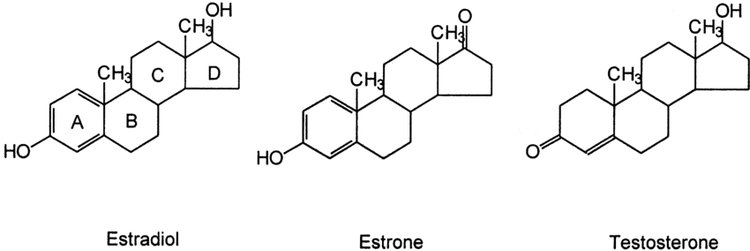
Nguyên nhân gây nám da ở nam giới do sự mất cần bằng nội tiết tố giữa estrogen và testosterone
2. Treatment of melasma in men
Many people assume that male patients don't really care about how their skin looks like women and are just reluctant to follow a skin care plan. However, men also have reasons to motivate adherence to prescribed regimens.
To encourage patient adherence, physicians often carefully consider the individual needs of each patient when creating a treatment regimen, as preferences and expectations can vary greatly between men and women gender. For example, some patients refuse to use products with fragrances, greasy textures or camouflage agents, even if they are not very interested in using daily skin care products. or several times a day. Your doctor will also advise on causes, prevention and treatment methods, and recurrence rates.
Avoiding the sun is the most important part of melasma treatment, both to improve the current condition and to prevent future recurrence. Broad spectrum sunscreens (UVA and UVB) along with inorganic (physical block) sunscreens such as zinc oxide or titanium dioxide with a sun protection factor of at least 15 are recommended. Regardless of gender, all patients should protect their skin from sun exposure, with emphasis on optimal and frequent sunscreen application, and the use of hats and protective clothing.
There is very little literature on the treatment of melasma in men. Most guidelines for treating melasma are based on studies done primarily in women. The recommendations for treating melasma for men are similar to those for women and there are no specific recommendations for men.
Various treatment options for melasma include the use of topical and oral depigmentation agents, chemical peels, and surgical methods, such as dermabrasion and laser irradiation. Although hydroquinone (HQ) and triple combination cream (HQ + retinoic acid [RA] + corticosteroid [CS]) remain the gold standard in treatment, alternative treatment options for topical use include compound (HQ + RA, CS + RA; HQ + CS), kojic acid, azelaic acid, arbutin, mequinol, ascorbic acid, tranexamic acid, rucinol, lignin peroxidase, orchid extract and licorice extract. Other treatments include chemical peels along with laser light therapy. In a study by Keeling et al., 5 men with melasma were treated with a combination of 2% mequinol and 0.01% retinoic acid solution, and after 12 weeks, four patients recovered. completely and one patient improved moderately.
Medical treatment is the mainstay of the management of melasma in men and a combination of methods can be used to optimize results. According to the theoretical review by Krupashankar et al., topical therapy with triple combination cream should be the first-line treatment for patients with melasma. Monotherapy and dual therapy are less effective, have a slower onset of action, and are recommended for patients who cannot access triple therapy or who are sensitive to the components.
An equally important member of anti-pigmentation weapons is chemical peels, such as glycolic acid, mandelic acid, lactic acid, trichloroacetic acid, and retinoids. However, people with darker skin should use caution when using melasma peels, as the incidence of side effects such as irritation and post-inflammatory hyperpigmentation will be higher.
Various studies have reported conflicting results with laser in the treatment of melasma. Although lasers can produce rapid and significant results in some patients, side effects such as irritation, post-inflammatory hyperpigmentation, hypopigmentation, and reversible hyperpigmentation may occur. recovery, especially in dark-skinned people. There is still disagreement in the literature about the safety, effectiveness, or durability of laser treatments and, therefore, they are not considered first-line treatments for melasma in both sexes. Laser treatment should only be used in cases that do not respond to topical therapy or chemical peels.

Tránh ánh nắng mặt trời là biện pháp điều trị quan trọng nhất
3. Summary
Melasma has traditionally been considered a pigmentary disorder in women, but this disease is not uncommon in men. Melasma seems to be more common in dark-skinned Asian and African-American men. Melasma can be aggravated by environmental factors such as sunlight, especially in patients with genetic predisposition. The pathogenesis of melasma in men is similar to that of women, except that hormonal factors are more common in women.
Treatment of melasma is often challenging, often unsatisfactory and needs to be continued indefinitely to avoid recurrence. To ensure optimal adherence, physicians often consider each patient's needs, preferences, and expectations when formulating a treatment plan. Patients need strict sun protection, including the use of sunscreen. Further studies on melasma in men of different population groups will help to better understand the difference compared with melasma in women.
Any questions that need to be answered by a specialist doctor as well as customers wishing to be examined and treated at Vinmec International General Hospital, you can contact Vinmec Health System nationwide or register online HERE.
Please dial HOTLINE for more information or register for an appointment HERE. Download MyVinmec app to make appointments faster and to manage your bookings easily.
References: ncbi.nlm.nih.gov, medicalnewstoday.com




